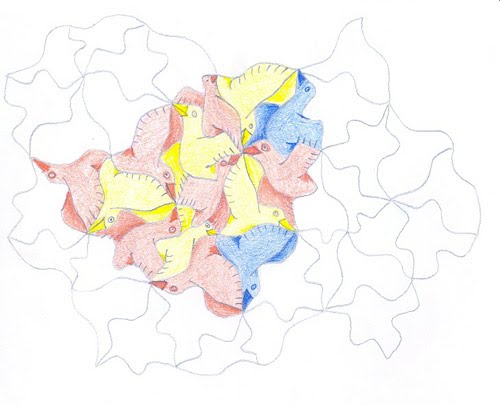Figure 1: Penrose Bird and Fish
(Collection of Edmund Harriss)
A very pleasing, high quality tessellation, of which, as alluded to in the introduction, tests one's skill, in different ways. Firstly, each motif has two different lines, with here the fish of the left top and bottom, and right, top and bottom. As such, there is nothing unusual in this, is very much in the nature as with a typical Escher tessellaiton, in which each line represents two aspects. However, with Penrose tilings, due to their non repeating nature, it also has to represent the other (bird) motif as well, so for each line it has to represent four aspects of the motif. As if this was not difficult enough to achieve, the same arrangement applies to the right side of the motif as well! Therefore, to 'Escherise' a Penrose tiling is fraught with difficulty. Consequently, the lines must be decidedly ambigous to an extent, of which, as I discuss in Essay **, such motifs (birds and fish) are surely the only possible ones to utilise. Certainly, one could not imagine say, a quadruped, with such shape specific lines being suitable. Secondly, another challenge is that of the thin rhomb, which at the vertices is somewhat 'pinched', and so this in itself causes its own difficulties.
Another aspect to this is the colouration, which is in this instance is based on one motif, one colour (note that to introduce variety, the motifs are two-toned, but the principle of one colour, one motif remains). As can be seen, this violates the map colouring rule, of having contigous regions of different colours. However, if this was desired, this would lose the 'minimum' coloring here.
As such, although the above may appear to be of a arbitrary patch, this is not so, as it is based on the Golden Ratio, with ratios of 34 to 21.
Figure 2 below shows a patch in greater detail.
Figure 2
Two Rhombs
This is based upon the two rhombs as above, of which for the purpose of adding bird motifs it was necessary to subdivide the tiles.
Study.
Due to the necessity of subdividing the rhombs, this thus effectively doubles the number of motifs, of which as discussed in Essay 1, generally (but not always results) in a diminuation in inherent quality. However, here although the motifs are not of the highest standard are certainly of an acceptable degree, and are not noticably lacking.
